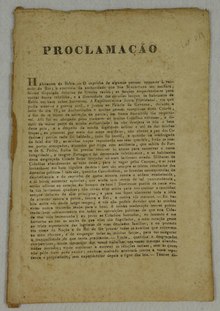Siege of Salvador (1822–1823)
| Siege of Salvador | |||||||
|---|---|---|---|---|---|---|---|
| Part of the Brazilian War of Independence | |||||||
 Entrada do Exército pacificador na Leal e Valorosa cidade capital da província de Bahia. Lithograph by Bento Capinam, c. 1830, depicts the triumphal entry of the Brazilian army into the capital of the province of Bahia | |||||||
| |||||||
| Belligerents | |||||||
|
|
| ||||||
| Commanders and leaders | |||||||
|
|
| ||||||
| Strength | |||||||
|
At the beginning: 1,500[1] At the end: 14,000[2] Ships:[3] 1 ship of the line 3 frigates 2 corvettes 3 brigs 1 charrua 1 brig-schooner |
At the beginning: 3,000[1] At the end: 10,500[2] Ships:[2] 1 ship of the line 2 frigates 8 corvettes 2 brigs 1 charrua 1 smack | ||||||
| Casualties and losses | |||||||
|
750 killed 280 wounded[citation needed] |
2,500 killed 700 wounded 300 captured[citation needed] | ||||||
The siege of Salvador occurred during the Brazilian War of Independence, during which the newly formed Brazilian army, under the command of French general Pierre Labatut, attempted to capture the city of Salvador in Bahia from its Portuguese defenders. The siege lasted from 2 March 1822 until 2 July 1823, finally ending when the Portuguese commander, Madeira de Melo, surrendered his forces to the Brazilians.[4]

Notes
- ^ a b Rodrigues 1975, p. 206.
- ^ a b c Rodrigues 1975, p. 218.
- ^ Maia 1975, pp. 72–74.
- ^ Diégues 2004, pp. 162–167.
References
- Rodrigues, José Honório (1975). Independência: Revolução e Contra-Revolução – As Forças Armadas. Rio de Janeiro: F. Alves.
- Diégues, Fernando (2004). A revolução brasílica. Rio de Janeiro: Objetiva.
- Maia, Prado (1975). A Marinha de Guerra do Brasil na Colônia e no Império. Rio de Janeiro: Cátedra.
